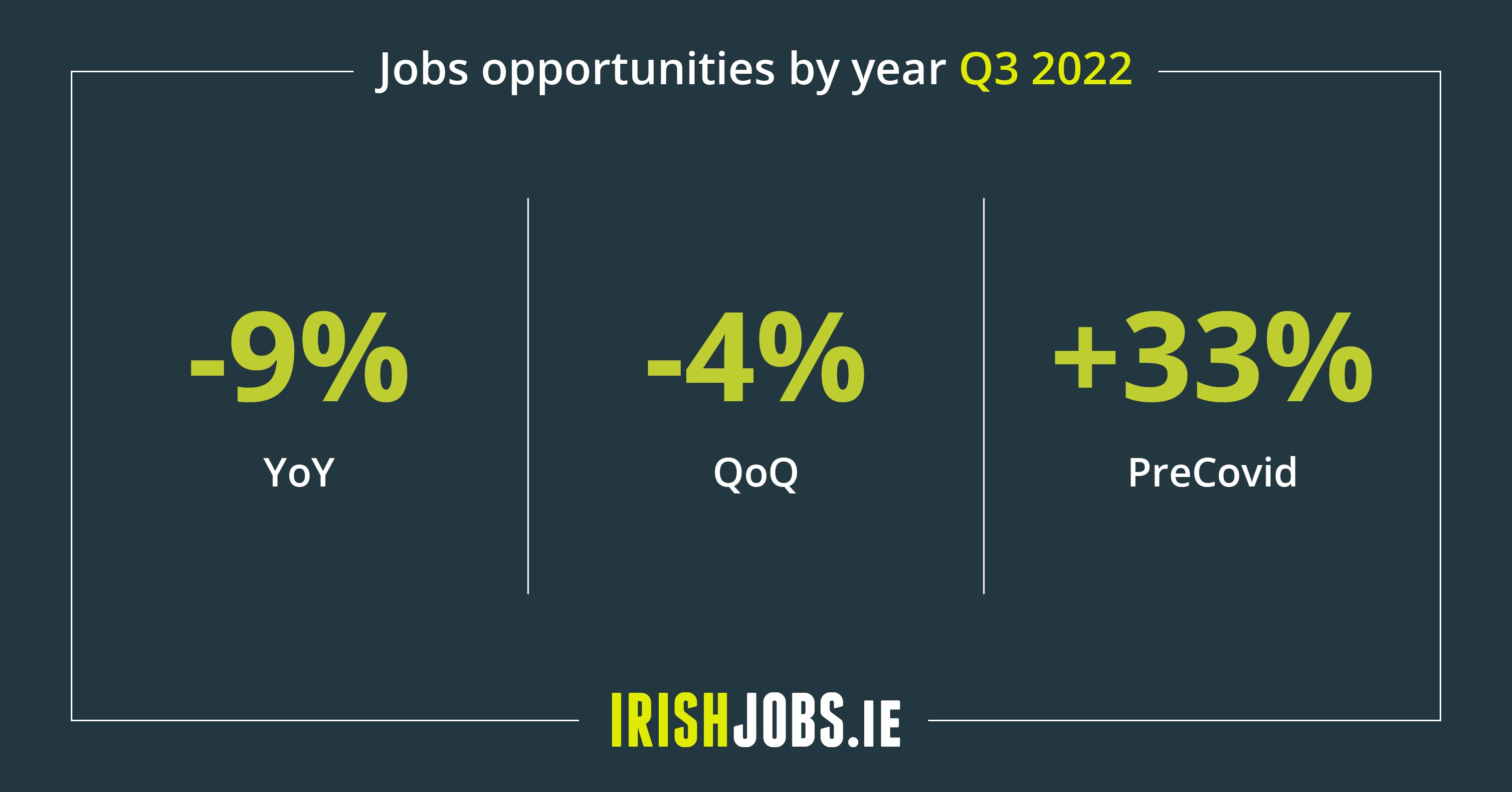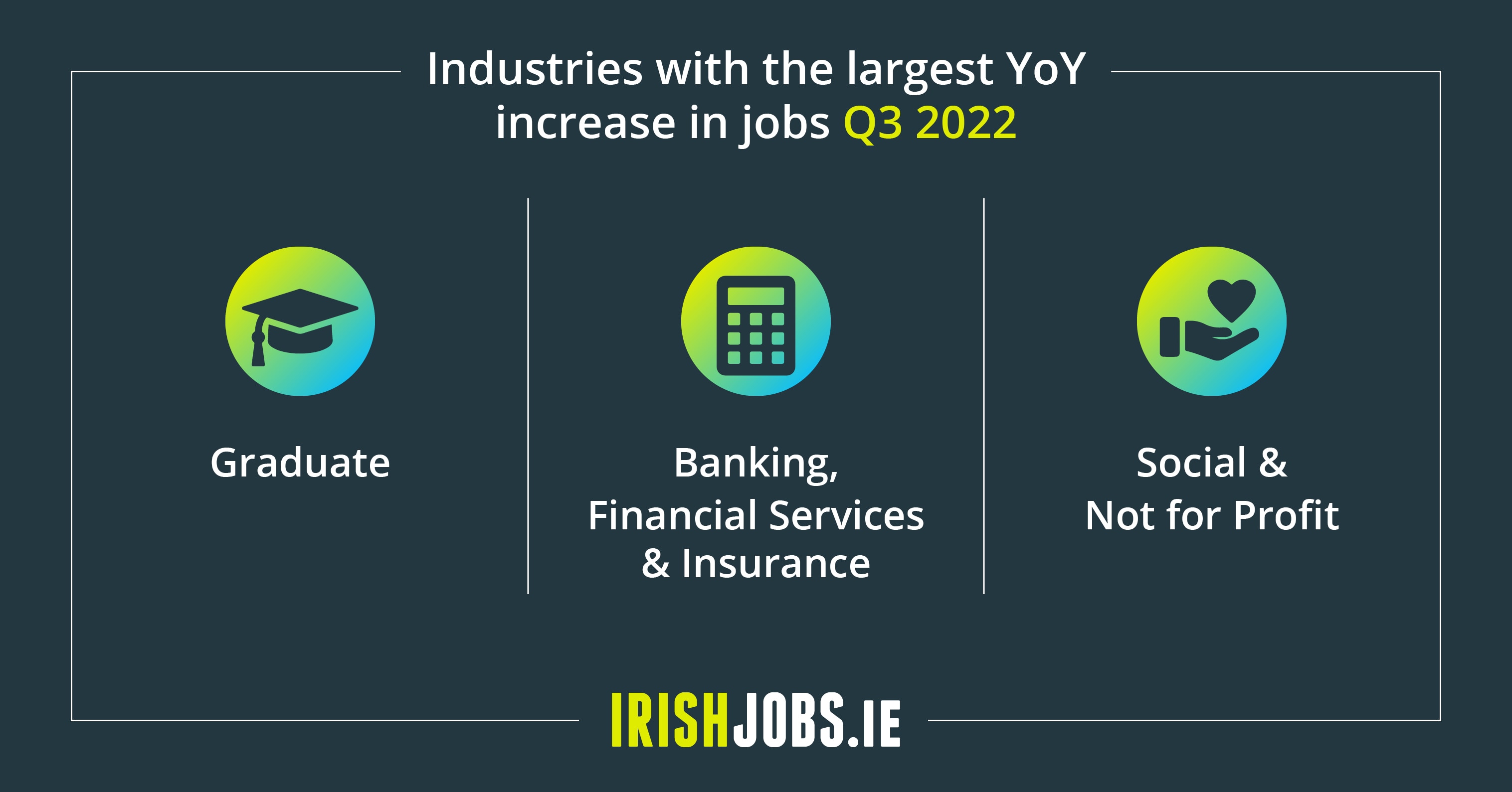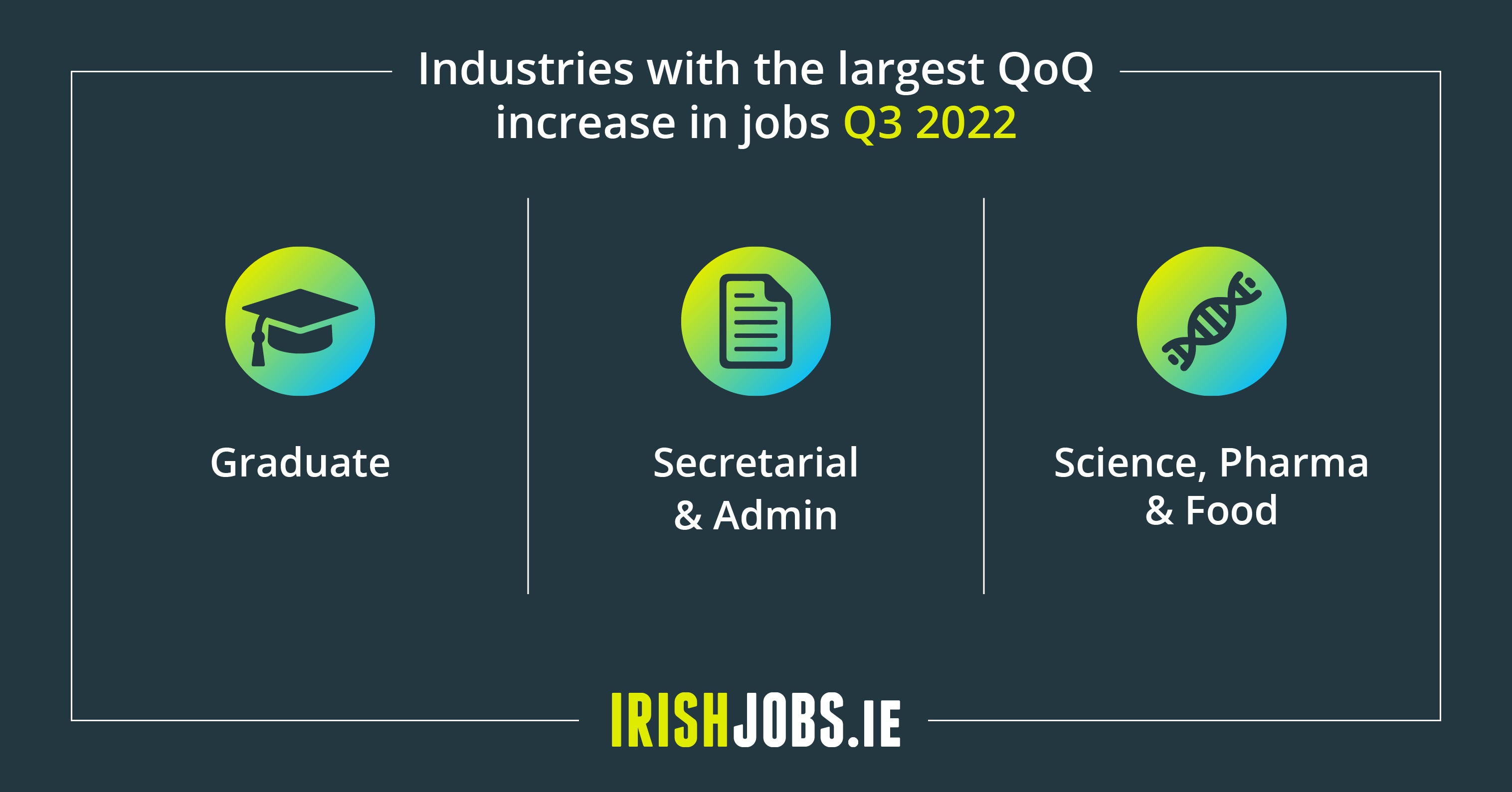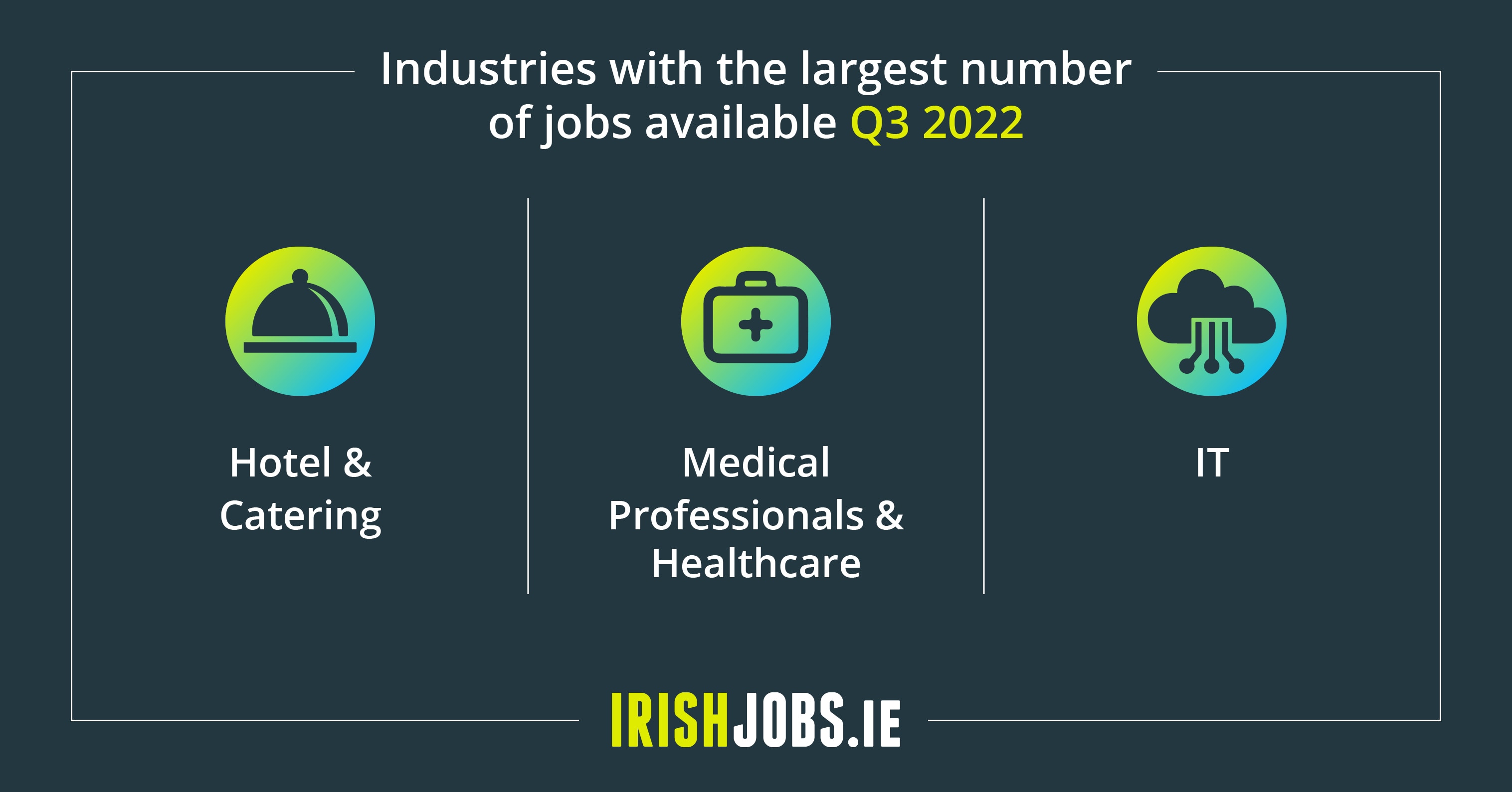The latest quarterly Jobs Index from the leading hiring platform, IrishJobs, reveals a change of pace in the recruitment market with the number of vacancies easing on a quarterly and yearly basis.
For the first time in seven quarters, the Index reveals that job vacancies across Ireland have decreased, with a -9% drop year-on-year and a -4% drop quarter-on-quarter.
This development comes off the back of slower growth noted in last quarter’s Index, which saw the number of jobs levelling out as a number of sectors approached the end of their post-Covid surges. However, with 33% more jobs available in this quarter compared to 2019 Q3, there are clear indications that the jobs market in Ireland remains robust overall.

Industry Analysis
Of the 31 sectors analysed in this quarter’s Index, 14 sectors have posted year-on-year increases in job vacancy creation, while 15 sectors have posted quarterly increases.
Sectors whose importance grew during Covid, while stabilising maintained growth when comparing QoQ and YoY data, with vacancies in IT up by 1% YoY and 7% QoQ while vacancies across Medical Professionals & Healthcare are up by 6% YoY with no change QoQ. Meanwhile, Graduate (+264% YoY; +70% QoQ), Secretarial & Admin (+18% YoY; +43% QoQ) and Engineering & Utilities (+10% YoY; +16% QoQ) have all posted steady increases in job vacancies also.
Certain sectors have posted year-on-year growth, but hesitancy is apparent at the quarterly level. These include some important business support and financial activities, including Banking, Financial Services & Insurance (+31% YoY; -5% QoQ), Accountancy & Finance (18% YoY; -1% QoQ) as well as Construction, Architecture & Property (5% YoY; -2% QoQ).
Sectors which are showing a decrease in job vacancies on an annual basis only include Science, Pharmaceutical & Food (-1% YoY; +15% QoQ), which has eased back from its Covid-era prominence but is still generating vacancies on a quarterly basis. Quarterly increases can also be observed in sectors that may still be working through a Covid-related pent-up demand. These include Beauty, Hair Care, Leisure & Sport (-13% YoY; +10% QoQ) and Tourism, Travel & Airlines (-46% YoY; + 17% QoQ).
Meanwhile, a total of 9 sectors have posted both year-on-year and quarterly declines. These sectors extend right across the domestic economy, from manufacturing [Production, Manufacturing & Materials (-20% YoY; -1% QoQ)] and business support services [HR & Recruitment (-19% YoY; -15% QoQ) through to retail [Retailing, Wholesaling & Purchasing (-21% YoY; -13% QoQ)] and hospitality [Hotel & Catering (-25% YoY; -16% QoQ)].
However, despite the sharp drop in quarterly and yearly vacancies for Hotel & Catering, this sector is still the largest source of job vacancies in 2022 Q3 (15%). In second place is General Management and Consulting (10%), with the Medical Professionals & Healthcare sector the next largest generator of job vacancies this quarter (9%).
Vacancies By Location
As regards vacancy gains by location, the third quarter fall in vacancies at the national level is underpinned by a range of experiences at the county level.
Seventeen counties have experienced a decrease in vacancies over the quarter, with particularly strong falls in Carlow (-44%), Donegal (-22%) and Roscommon (-20%). These falls contrast with strong quarterly vacancy increases in Cork (+23%) and Waterford (+13%).
Meanwhile, the strongest year-on-year gains in vacancies were recorded in Cork (+16%) and Offaly (+13%).
When it comes to the number of jobs offering remote work, the latest IrishJobs Jobs Index is the first since 2019 Q3 to display a fall in working from home vacancies, with the rate of the decrease (-9%) greater than that of all vacancies combined. However, when compared to the same period last year, the figure remains 20% higher.
Insights
Commenting on the results of the latest IrishJobs Jobs Index, Orla Moran, General Manager, IrishJobs.ie, said: “The IrishJobs Jobs Index, based on quarterly job vacancy data, is an important window through which current Irish economic activity can be assessed.
“This latest Index reveals that, following the levelling out of jobs vacancies in Q2 2022, jobs have decreased on both a yearly and quarterly basis. However, as we consider these figures, we must acknowledge that Q3 2021 was a particularly buoyant quarter, as the country emerged from a long lockdown with the gradual reopening of hospitality across the country. This, along with the fact that Q3 generally sees a decline in comparison to the summer months of Q2, might help to take the edge off what might otherwise seem an uncertain outlook for job vacancies across Ireland. Furthermore, it’s encouraging to note that overall job vacancies are up by a third on pre-Covid levels.
“That said, there’s no doubt that employers across Ireland are responding to the shock that has hit domestic and global economies. Exorbitant energy prices subsequent to Russia’s invasion of Ukraine negatively affect both producers via higher production costs and consumers via diminished purchasing power. This, on top of a decline in consumer sentiment as a result of the economic outlook, is borne out by the wide range of domestic sectors that have posted declining job vacancy rates in 2022 Q3. Despite this, we’re still seeing a rise in job applications, in September for example, applications were up 20% through IrishJobs compared to the same month last year.
“While economic uncertainty continues, it’s crucial that employers and jobseekers across Ireland continue to track hiring and job-seeking activity. By keeping a close eye on how companies and employees are responding to rapidly changing economic conditions, employers can be better positioned to plan and improve their own recruitment and retention strategies, while job seekers can equip themselves with the vital insights they need to better navigate an evolving and increasingly competitive hiring environment.”



